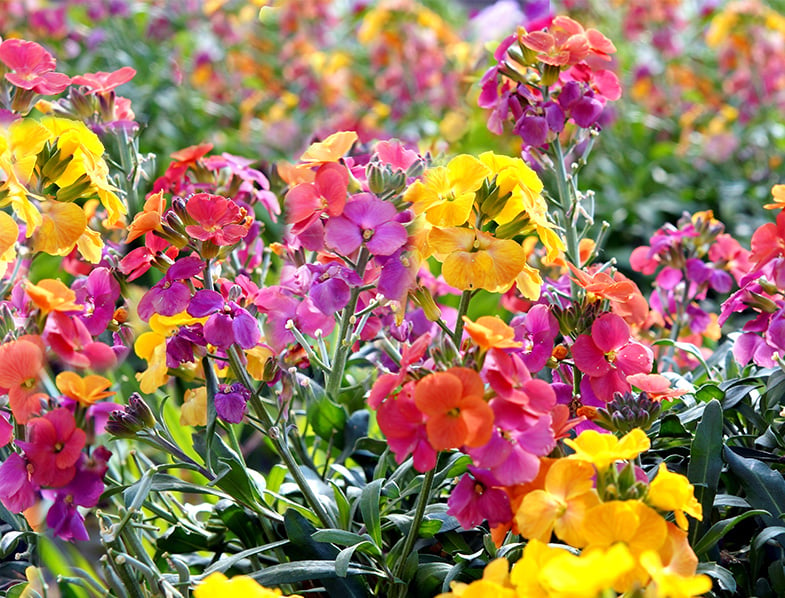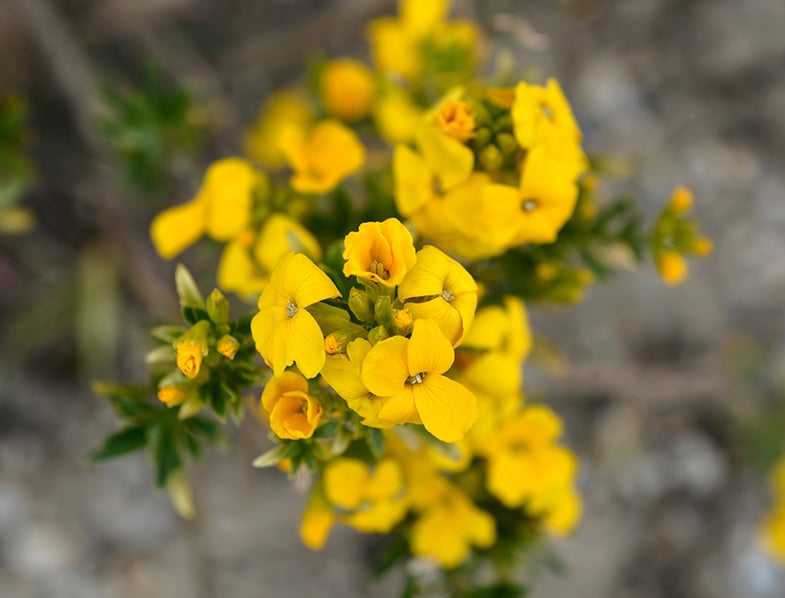Are you looking for some adorable and low-maintenance flowers to add to your plant family? Well, we have the perfect candidates for you! Besides their colorful and fragrant blossoms, Erysimum plants a.k.a Wallflowers have all it takes to be your next favorites.
Erysimum is a genus that contains over 150 different species of flowering plants, so you will have plenty of options to choose from! The flowers from this genus are native to many regions worldwide including southwest Asia, Europe, the Mediterranean, Africa (Cabo Verde), and North America.
Wallflowers are very versatile plants that can grow at their best both indoors and outdoors. These plants make wonderful additions to rock gardens, mass planting, beds, borders, and make for excellent edging or cascading specimens. They also look very cute in containers.
About Erysimum
- Erysimum belongs to the Brassicaceae family, making these plants closely related to plants like broccoli, cabbage, cauliflower, kale, turnips, and others.
- Although all species and varieties deserve mention, some specimens are more popular in the gardening world than others. These interesting cultivars are ‘Apricot Delight’, ‘Bowles’s Mauve’, ‘Fragrant Sunshine’, ‘Red Jep’, and ‘Winter Orchid’.
- The spectacular E. ‘Bowles’s Mauve’ cultivar has gained the well-known Award of Garden Merit. This buddy comes with vibrant and hypnotic mauve flowers.
- Different Erysimum species play a big part in the ecology of their natural habitat. They serve as a food source for the larvae of some moths and butterflies. Moreover, some species of weevils live inside their fruits and feed on their seeds.
- Numerous species of herbivore mammals, such as red deer, argali, mule deer, or Spanish ibex, use their fruiting and blooming stalk as a tasty food source.
- Their blooms are not attractive only for us, humans. Various species of pollinators (bees, butterflies, ants, bee flies, beetles, hoverflies, and more) love to visit Erysimum gardens.
- In traditional medicine, people used Wallflowers as a treatment for several problems like heart diseases, menstrual irregularities, fevers, injuries of the eyes, or as diuretics.
- The stems and flowers of Erysimum plants have antispasmodic, antirheumatic, resolvent, nervine, emmenagogue, and cardiotonic properties. Their seeds are tonic, diuretic, stomachic, expectorant, and even aphrodisiac. However, it is not recommended to use or consume them without medical guidance.
- Erysimum blossoms contain an essential oil that has a pleasing scent. If diluted, the essential oil of some species serves as a nice fragrance in the perfume industry.

Erysimum Features: An Overview
- Depending on the variety, Erysimum plants are annuals, biennials, or herbaceous perennials. Most species are shrubs or sub-shrubs, but there are also a few ground-cover specimens.
- In general, Wallflowers grow at a pretty fast pace and spread in all directions. They can reach from 1 to 3 feet (30-91 cm) in both height and width.
- Their evergreen foliage consists of upper leaves, lower leaves, and erect, hairy, somewhat winged stems. The lower leaves are linear to oblanceolate, while the upper ones are narrow and sessile.
- Their blooming period lasts for a very long time, usually from spring through late autumn. During these seasons, Erysimum plants produce numerous inflorescences with attractive blossoms that appear in dense clusters.
- The flowers of these plants have 4 to 5 petals and are very fragrant as well. They exhibit various tints of white, yellow, orange, red, blue, pink, or purple.
- Erysimum plants produce dry, green fruits. The fruits split open when ripe and contain many brown to black seeds.
- Wallflowers look absolutely fabulous near other flowering plants. The most popular companions for them are Double Late Tulip, Honesty, Lady’s Mantle, Lily-Flowered Tulip, Ornamental Onion, Triumph Tulip, Wood Forget-Me-not, and Yarrow.
Growing Erysimum
In general, Erysimum plants grow at their best in bright, sunny locations. These flowers can also withstand a bit of partial shade but they will not bloom as much. The lighting conditions for them depend directly on the region you are living in. In northern climates, you can grow your plants in a spot where they can receive at least six hours of direct light daily. In southern areas, provide them with some shade to protect them from intense afternoon sunlight.
To remain all nice and green, Wallflowers will need warm temperatures all year round. These plants are usually hardy in USDA zones 6 to 9. However, they can also overwinter in regions with colder climates.
Although Erysimum plants are typically carefree in dry growing conditions, they can encounter some issues in areas with moisture. The most common pests that can bother your buddies occasionally are aphids, flea beetles, and cabbage worms. These intruders will feed on your plant’s stems and leaves, making them very easy to spot from the beginning.
If you notice any suspect presence on your Wallflowers, you must first handpick the pests. Secondly, you should rub your plants’ foliage using a cotton pad dipped in rubbing alcohol. In case of severe infestation, apply suitable insecticides or pesticides.
- Planting Depth: 1/4"
- Seed Spacing: 12-15"
- Temperature: 65-75°F
- Days to Germination: 5-7
- Days to Maturity: 60-70
- A beautiful herbaceous evergreen perennial plant native to Greece that grows up to 12-18 inches tall and 12 inches wide
- The plant grows only leaves in the 1st year, then in the 2nd year it blooms; The flowers are followed by long seed pods
- The plant grows on walls, cliffs, and rocks; It is ideal for planting in beds, borders, balconies, stony hills, containers and for cutting; It is also known for its medicinal properties
- The latin name of Wallflower Cheiranthus comes from the Greek words “cheir”, which means “hand” and “anthos” meaning “flower”
- Should you have any questions or issues with your order do not hesitate to contact us; We would be happy to help
- EXTRA LARGE PACKET contains over 1 full ounce of pure live seeds (2,000+ seeds!) - Enough to cover 250 square feet.
- THE FRESHEST SEEDS available lead to high germination rates, making your gardening easy, successful, and fun!
- PREMIUM PACKAGING designed for optimal seed storage, with full planting instructions and reusable zipper - Great for gift giving!
- GUARANTEED TO GROW! – We want everyone to be a successful gardener, and we’re always here with personal gardening advice. If you have any issue with our seeds, we’ll refund or replace them no questions asked!
- DAZZLING BRIGHT ORANGE BLOOMS are an easy-to-grow delight in any home garden or hillside!
Last update on 2024-10-01 / Affiliate links / Images from Amazon Product Advertising API
Planting Erysimum
What most gardeners appreciate about Erysimum plants is their ability to grow in almost any type of soil. Be careful, though, as they will not do so well in soils that retain too much moisture and will eventually die off. For optimal growth, plant your flowers in a dry to slightly damp substrate that has excellent drainage. If you want to grow your plants indoors, make sure you are planting them in a pot that has drainage holes at the bottom.
Wallflowers are easy-going plants that do not require a lot of additional fertilizer to thrive. These plants will do just fine if you manage to mix some compost into the soil before their first planting. You can also provide them with an all-purpose fertilizer in early spring and mid-summer to give them a nice boost.
In general, Erysimum plants have a tendency to grow and spread like crazy. You can control this habit and maintain a certain size and shape for your shrubs by pruning them regularly. In early spring or once their blooming period has ended, you should cut your plants back. This process consists of pruning your Wallflowers back until they have only a couple of inches above the soil. If you are doing this properly, they will reward you with dense growth when the weather warms up again.
Deadheading is also mandatory in your Wallflowers’ caring routine to keep them healthy and ensure profuse flowering. During their blooming period, you must remove all spent flowers to make room for new ones to show their splendour.
Watering Erysimum
Like most species of shrubs, Erysimum plants are tolerant of drought for long periods. This particular feature makes them ideal for beginner, busy, or forgetful gardeners. In fact, these flowers can grow just fine only with regular moisture from rainwater. Yet, if you live in a region with infrequent rainfalls, you may need to provide your shrubs with water from time to time.
Keep in mind that Wallflowers are susceptible to root rot and do not appreciate having their feet wet. As a general rule, you should water your plants only when their soil has dried out completely. We recommend you check the soil in-between waterings to avoid any soggy conditions.
In terms of humidity, Erysimum plants are quite adaptable and can tolerate a wide range of levels. These flowers can typically handle both dry and moist growing conditions. However, they do not appreciate very high humidity levels, so you should avoid growing them in wet areas of your garden.

Propagating Erysimum
Erysimum plants are not very long-lived in general, but propagating these flowers can make them immortal! And when they are so nice-looking and fragrant, how could you possibly want to part ways with them? Luckily, you can propagate these shrubby friends through cuttings and seeds with little to no effort.
If you want to use cuttings in this process, you must first look for healthy stems on your mature Wallflowers. Once you have spotted the most attractive stems, cut about 2-3 inches (5-8 cm) off them in late spring. Make sure you remove all leaves from the bottom half of each stem and leave only 3-4 leaflets on the upper half. Moreover, pinch off any blossoms and flower buds.
For better results, you should dip the cut end of each stem cutting into a rooting hormone. After this process, plant your Erysimum cuttings in fresh soil or compost. Place the container in a well-lit location. Provide the cuttings with water regularly to maintain the substrate slightly damp. When the cuttings develop a healthy root system, you can transplant them in their permanent spots.
Sowing seeds is also a great method to propagate Erysimum plants. You can either sow the seeds outdoors directly into the garden or start them indoors in containers. Wallflowers seeds will germinate faster if you plant them in early spring or late fall. With lots of sunlight and constant moisture, the seedlings will usually show up in several weeks.
In Conclusion
Having at least one species of Erysimum plants around can bring you nothing but joy! Their flowers are truly stunning and will keep you company for almost a whole year. If you want to bring a unique member to your collection this year, these easy-going beauties are exactly what you need!



